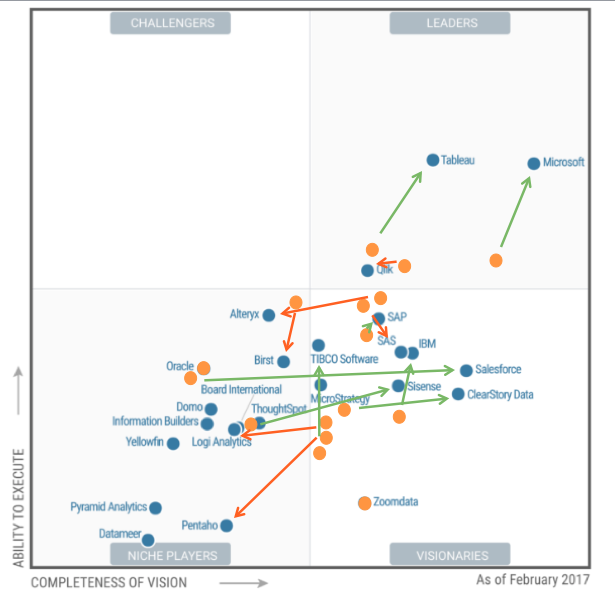
by twieberneit | Mar 26, 2018 | Analysis, Blog |
A brief while ago I had the chance of talking to Andy Byrne, CEO of Clari, about how AI can help making sales organizations more effective and efficient. Clari is a vendor of Opportunity-to-Close solutions. G2Crowd lists the company amongst the leaders of its Sales Analytics Software quadrant, while Gartner Group in 2017 named it a cool vendor in the Tech Go-To-Market. Shortly after the conversation Clari announced the closure of a $35 Million funding round “following record growth”, essentially a tripling of their customer base while maintaining a near 100 per cent renewal rate. According to Andy, the company applies “machine learning focused on sales”, i.e. predictive and prescriptive analytics to improve pipeline visibility and to get more insight into which opportunities are more likely to close than others. This helps in focusing on these opportunities. This solution was developed after having in depth conversation with a number of big sales teams, figuring out their challenges/problems. As a result of this the company is addressing three problems. Many to most sales reps do not consider CRM systems (or SFA systems, for that matter) as particularly helpful. Sales managers do have a poor visibility into what their teams are doing, with which opportunities they spend their time. Executives and Sales Operations are dealing with “XLS hell” because the system’s forecasting ability is broken. All in all, points two and three are consequences of point one. If a system is not of help it is a time-waster and tends to be avoided. Data about opportunities will not be entered in a timely manner nor will it be very accurate. Clari’s...

by twieberneit | Jun 20, 2017 | Analysis, Blog |
A while ago Angela Lipscomb from SAS got in touch with me to get me introduced to SAS’s concept of a Customer Decision Hub. Their Customer Decision Hub is a solution concept that shall allow organizations to derive insights and to trigger actions from interactions with external parties, like customers based upon rules and the derived insights. A Customer Decision Hub e.g. orchestrates the determination of Next Best Actions, and allows responding to an incoming request in real time using analysis and decision logic. At the same time standard communications can get suppressed based upon the same set of rules. In other words, the Customer Decision Hub fosters customer engagement based upon inbound signals that get analyzed and processed through the organization. Why is this remarkable, I hear you asking? It is remarkable because SAS Software first of all is an analytics company with a strong reputation for enterprise analytics at the higher end of performance and price point. SAS describes itself on LinkedIn as “the leader in business analytics software and services, and the largest independent vendor in the business intelligence market. Through innovative solutions, SAS helps customers at more than 70,000 sites improve performance and deliver value by making better decisions faster. Since 1976 SAS has been giving customers around the world the power to know®.” SAS is not a company that is widely known for being actively engaged in the customer engagement market (pun intended). So I was intrigued. And so should you be. Finally, a few days ago my somewhat erratic schedule allowed me to have a follow-up with Troy Kusabs of SAS Software in...

by twieberneit | Feb 22, 2017 | Analysis, Blog |
Last week Gartner published the updated version of its Magic Quadrant for Business Intelligence and Analytics Platforms, and I need to say that there has been a lot of movement in both directions, up as well as down. There has been a lot of reshuffling especially in the Visionaries quadrant. This can partly be attributed to a changing market that caused Gartner to combine a few of last year’s assessment criteria as well as adding two more critical criteria as below: Critical Capabilities Dropped or Changed: Combined BI Platform Administration with Security and User Administration Modified Data Source Connectivity to Data Source Connectivity and Ingestion Combined Publish Analytics Content and Collaboration and Social BI to Publish, Share and Collaborate on Analytic Content Added Visual Appeal to Ease of Use Capabilities Added: Smart Data Discovery Platform Capabilities Workflow Integration Smart Data Discovery emphasizes the increasing importance of AI and machine learning as part of analytics systems. Gartner defines it around the automatically “finding, visualizing and narrating of important findings such as correlations, exceptions, clusters, links and predictions in data that are relevant to users without requiring them to build models or write algorithms. Users explore data via visualizations, natural-language-generated narration, search and natural-language query technologies”. Workflow Integration acknowledges that there is no actionable insight if there is a standalone analytics system. It is defined around the number of products “needed to deliver the critical capabilities and the degree of seamless integration and workflow between capabilities/components”. This has been true for a long time, but hey, better late than never. Gartner itself states that the changes have been major and that...

by twieberneit | Oct 13, 2016 | Blog |
A while after my earlier discussion with Abinash Tripathy from Helpshift about the value for customer experience of bots in customer support he contacted me with some exciting news about what he and his team are doing now. Believe me, it is interesting – but read for yourself. Our conversation, of course, led on to another vivid discussion about things to come and things that in our opinions should come. The bottom line is that we live in a data driven, always on, real-time world, where prediction of events or the ability to suggest an action is becoming increasingly a differentiator … be it in a B2B- or a B2C world. Think of Rolls-Royce selling uptime of their engines, entire airplanes nearly continuously sending telemetry data “home”, or the massive amount of data that a Formula 1 car continually sends in order for the team to take proper real-time decisions. Any car already collects a lot of data – it just needs to get connected to allow for prediction of maintenance to prevent failures. Or think of entire power grids that are already instrumented in a way that allows the operator to predict a failure several days in advance, so that the affected element can get fixed before it fails. It is all in the data? The secret is in having the data. And in the algorithms, be they event- and rule based, or more sophisticated and using machine- or deep learning. Neither data nor algorithms alone are the goal. Because what is needed is actionable insight. Actionable insight emerges only if the right algorithms are applied to the...

by twieberneit | May 16, 2016 | Blog |
the Future of Retail is, well, interesting. Retailers today face an increasingly fierce competition. This competition is both, between brick-and-mortar retailers as well as between online-retailers and brick-and-mortar. Amazon, for example, is eating an increasing share of department stores’ lunch. It already now is the second largest apparel retailer in the US. According to Morgan Stanley research, quoted in a recent business insider article: “Internet retailers (led by Amazon) have added $27.8 billion to their apparel revenue since 2005, while dept stores have lost $29.6 billion,” … “This share loss appears at risk of accelerating given 1) Amazon’s bigger push into fashion, and 2) consumer willingness/acceptance to shop fashion through Amazon.” Additionally, customers are increasingly demanding, which is fuelled by being better informed and by the willingness to leverage this information. As a result of both of these trends retailers are losing relevance. One of the main challenges facing retailers (and brands, btw) is that big scale online retailers can very strongly compete on price. They also have a strong edge in data, which fuels their online experience. But here is also the chief weakness of online retailers like Amazon: They are online retailers, which confines the experience that they can offer to, well, online. Consumers used and use stores for showrooming to get a physical experience of the product and/or service. This is a clear indication that online is not everything! Which is one of the reasons why Amazon experiments with Internet of Things devices like their Dash button, which they recently enhanced with an SDK; it does also explain why Amazon is experimenting with kiosks and retail stores....






